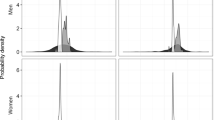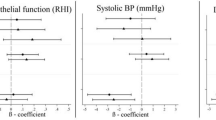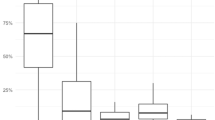Abstract
Mixed-effects models were used to estimate within-person and between-person variance components, and some determinants of environmental exposure to particulate matter (PM2.5), black smoke (BS) and trace elements (Cl, K, Ca, Ti, Fe, Ni, Cu, Zn, and Pb) for personal measurements from 30 adult subjects in Gothenburg, Sweden. The within-person variance component dominated the total variability for all investigated compounds except for PM2.5 and Zn (in which the variance components were about equal). Expressed as fold ranges containing 95% of the underlying distributions, the within-person variance component ranged between 5-fold and 39-fold (median: sixfold), whereas the between-person variance component was always <sixfold (median: threefold). The relatively large within-person variance components can lead to attenuation bias in exposure–response relationships and point to the importance of obtaining repeated samples of PM exposure from study subjects in epidemiological investigations of urban air pollution. On the basis of the variance components estimated for the various particulate species, between 3 and 39 repeated measurements per subject would be required to limit attenuation bias to 20%. Significant determinants for personal exposure levels were urban background air concentrations (PM2.5, BS, Cl, Zn, and Pb), cigarette smoking (PM2.5, BS, K, and Ti), season (PM2.5, Fe, and Pb), and the time spent outdoors or in traffic (Fe).
This is a preview of subscription content, access via your institution
Access options
Subscribe to this journal
Receive 6 print issues and online access
$259.00 per year
only $43.17 per issue
Buy this article
- Purchase on Springer Link
- Instant access to full article PDF
Prices may be subject to local taxes which are calculated during checkout
Similar content being viewed by others
References
Adgate J.L., Mongin S.J., Pratt G.C., Zhang J., Field M.P., and Ramachandran G., et al. Relationships between personal, indoor, and outdoor exposures to trace elements in PM(2.5). Sci Total Environ 2007: 386 (1–3): 21–32.
Adgate J.L., Ramachandran G., Pratt G.C., Waller L.A., and Sexton K. Spatial and temporal variability in outdoor, indoor, and personal PM2.5 exposure. Atmos Environ 2002: 36 (20): 3255–3265.
Brown K.W., Sarnat J.A., Suh H.H., Coull B.A., and Koutrakis P. Factors influencing relationships between personal and ambient concentrations of gaseous and particulate pollutants. Sci Total Environ 2009: 407 (12): 3754–3765.
Brunekreef B., Noy D., and Clausing P. Variability of exposure measurements in environmental epidemiology. Am J Epidemiol 1987: 125 (5): 892–898.
Burstyn I., Kromhout H., Kauppinen T., Heikkila P., and Boffetta P. Statistical modelling of the determinants of historical exposure to bitumen and polycyclic aromatic hydrocarbons among paving workers. Ann Occup Hyg 2000: 44 (1): 43–56.
Chang M.J., Naworal J.D., Walker K., and Connell C.T. Investigations on the direct introduction of cigarette smoke for trace elements analysis by inductively coupled plasma mass spectrometry. Spectrochim Acta B 2003: 58 (11): 1979–1996.
Clayton C.A., Perritt R.L., Pellizzari E.D., Thomas K.W., Whitmore R.W., and Wallace L.A., et al. Particle Total Exposure Assessment Methodology (PTEAM) study: distributions of aerosol and elemental concentrations in personal, indoor, and outdoor air samples in a southern California community. J Expo Anal Environ Epidemiol 1993: 3 (2): 227–250.
Ebelt S.T., Petkau A.J., Vedal S., Fisher T.V., and Brauer M. Exposure of chronic obstructive pulmonary disease patients to particulate matter: relationships between personal and ambient air concentrations. J Air Waste Manag Assoc 2000: 50 (7): 1081–1094.
Egeghy P.P., Quackenboss J.J., Catlin S., and Ryan P.B. Determinants of temporal variability in NHEXAS-Maryland environmental concentrations, exposures, and biomarkers. J Expo Anal Environ Epidemiol 2005: 15 (5): 388–397.
Gotschi T., Oglesby L., Mathys P., Monn C., Manalis N., and Koistinen K., et al. Comparison of black smoke and PM2.5 levels in indoor and outdoor environments of four European cities. Environ Sci Technol 2002: 36 (6): 1191–1197.
Gustafson P., Barregard L., Lindahl R., and Sallsten G. Formaldehyde levels in Sweden: personal exposure, indoor, and outdoor concentrations. J Expo Anal Environ Epidemiol 2005: 15 (3): 252–260.
Hagstrom K., Lundholm C., Eriksson K., and Liljelind I. Variability and determinants of wood dust and resin acid exposure during wood pellet production: measurement strategies and bias in assessing exposure-response relationships. Ann Occup Hyg 2008: 52 (8): 685–694.
Hornung R.W., and Reed L.D. Estimation of average concentration in the presence of nondetectable values. Appl Occup Environ Hyg 1990: 5: 46–51.
Janssen N.A., Hoek G., Brunekreef B., and Harssema H. Mass concentration and elemental composition of PM10 in classrooms. Occup Environ Med 1999: 56 (7): 482–487.
Janssen N.A., Hoek G., Brunekreef B., Harssema H., Mensink I., and Zuidhof A. Personal sampling of particles in adults: relation among personal, indoor, and outdoor air concentrations. Am J Epidemiol 1998: 147 (6): 537–547.
Janssen N.A., Lanki T., Hoek G., Vallius M., de Hartog J.J., and Van Grieken R., et al. Associations between ambient, personal, and indoor exposure to fine particulate matter constituents in Dutch and Finnish panels of cardiovascular patients. Occup Environ Med 2005: 62 (12): 868–877.
Johannesson S., Gustafson P., Molnar P., Barregard L., and Sallsten G. Exposure to fine particles (PM2.5 and PM1) and black smoke in the general population: personal, indoor, and outdoor levels. J Expo Sci Environ Epidemiol 2007: 17 (7): 613–624.
Kim D., Sass-Kortsak A., Purdham J.T., Dales R.E., and Brook J.R. Sources of personal exposure to fine particles in Toronto, Ontario, Canada. J Air Waste Manag Assoc 2005: 55 (8): 1134–1146.
Kinney P.L., Aggarwal M., Northridge M.E., Janssen N.A., and Shepard P. Airborne concentrations of PM(2.5) and diesel exhaust particles on Harlem sidewalks: a community-based pilot study. Environ Health Perspect 2000: 108 (3): 213–218.
Koistinen K.J., Edwards R.D., Mathys P., Ruuskanen J., Kunzli N., and Jantunen M.J. Sources of fine particulate matter in personal exposures and residential indoor, residential outdoor and workplace microenvironments in the Helsinki phase of the EXPOLIS study. Scand J Work Environ Health 2004: 30 (Suppl 2): 36–46.
Koistinen K.J., Hanninen O., Rotko T., Edwards R.D., Moschandreas D., and Jantunen M.J. Behavioral and environmental determinants of personal exposures to PM2.5 in EXPOLIS—Helsinki, Finland. Atmos Environ 2001: 35 (14): 2473–2481.
Kromhout H., Symanski E., and Rappaport S.M. A comprehensive evaluation of within- and between-worker components of occupational exposure to chemical agents. Ann Occup Hyg 1993: 37 (3): 253–270.
Kromhout H., Tielemans E., Preller L., and Heederik D. Estimates of individual dose from current exposure measurements. Occup Hyg 1996: 3 (23): 23–39.
Lanki T., Ahokas A., Alm S., Janssen N.A., Hoek G., and De Hartog J.J., et al. Determinants of personal and indoor PM2.5 and absorbance among elderly subjects with coronary heart disease. J Expo Sci Environ Epidemiol 2007: 17 (2): 124–133.
Lee K., Bartell S.M., and Paek D. Interpersonal and daily variability of personal exposures to nitrogen dioxide and sulfur dioxide. J Expo Anal Environ Epidemiol 2004: 14 (2): 137–143.
Liljelind I.E., Rappaport S.M., Levin J.O., Stromback A.E., Sunesson A.L., and Jarvholm B.G. Comparison of self-assessment and expert assessment of occupational exposure to chemicals. Scand J Work Environ Health 2001: 27 (5): 311–317.
Lin Y.S., Kupper L.L., and Rappaport S.M. Air samples versus biomarkers for epidemiology. Occup Environ Med 2005: 62 (11): 750–760.
Liu L.J., Box M., Kalman D., Kaufman J., Koenig J., and Larson T., et al. Exposure assessment of particulate matter for susceptible populations in Seattle. Environ Health Perspect 2003: 111 (7): 909–918.
Mishra U.C., Shaikh G.N., and Sadasivan S. Trace-elements in tobacco and tobacco-smoke by X-ray-fluorescence technique. J Radioan Nucl Ch Ar 1986: 102 (1): 27–35.
Molnar P., Bellander T., Sallsten G., and Boman J. Indoor and outdoor concentrations of PM2.5 trace elements at homes, preschools and schools in Stockholm, Sweden. J Environ Monit 2007: 9 (4): 348–357.
Molnar P., Johannesson S., Boman J., Barregard L., and Sallsten G. Personal exposures and indoor, residential outdoor, and urban background levels of fine particle trace elements in the general population. J Environ Monit 2006: 8 (5): 543–551.
Pellizzari E.D., Clayton C.A., Rodes C.E., Mason R.E., Piper L.L., and Fort B., et al. Particulate matter and manganese exposures in Toronto, Canada. Atmos Environ 1999: 33 (5): 721–734.
Peretz C., Goren A., Smid T., and Kromhout H. Application of mixed-effects models for exposure assessment. Ann Occup Hyg 2002: 46 (1): 69–77.
Pope III C.A., and Dockery D.W. Health effects of fine particulate air pollution: lines that connect. J Air Waste Manag Assoc 2006: 56 (6): 709–742.
Preller L., Kromhout H., Heederik D., and Tielen M.J. Modeling long-term average exposure in occupational exposure-response analysis. Scand J Work Environ Health 1995: 21 (6): 504–512.
Rappaport S.M. Assessment of long-term exposures to toxic substances in air. Ann Occup Hyg 1991: 35 (1): 61–121.
Rappaport S.M., and Kupper L.L. Variability of environmental exposures to volatile organic compounds. J Expo Anal Environ Epidemiol 2004: 14 (1): 92–107.
Rappaport S.M., and Kupper L.L. Qantitative Exposure Assessment. Stephen Rappaport, El Cerrito, CA, USA, 2008.
Rappaport S.M., Weaver M., Taylor D., Kupper L., and Susi P. Application of mixed models to assess exposures monitored by construction workers during hot processes. Ann Occup Hyg 1999: 43 (7): 457–469.
Rojas-Bracho L., Suh H.H., Catalano P.J., and Koutrakis P. Personal exposures to particles and their relationships with personal activities for chronic obstructive pulmonary disease patients living in Boston. J Air Waste Manag Assoc 2004: 54 (2): 207–217.
Sarnat J.A., Brown K.W., Bartell S.M., Sarnat S.E., Wheeler A.J., and Suh H.H., et al. The relationship between averaged sulfate exposures and concentrations: results from exposure assessment panel studies in four U.S. cities. Environ Sci Technol 2009: 43 (13): 5028–5034.
Schlesinger R.B. The health impact of common inorganic components of fine particulate matter (PM2.5) in ambient air: a critical review. Inhal Toxicol 2007: 19 (10): 811–832.
Schlesinger R.B., Kunzli N., Hidy G.M., Gotschi T., and Jerrett M. The health relevance of ambient particulate matter characteristics: coherence of toxicological and epidemiological inferences. Inhal Toxicol 2006: 18 (2): 95–125.
Sorensen M., Loft S., Andersen H.V., Raaschou-Nielsen O., Skovgaard L.T., and Knudsen L.E., et al. Personal exposure to PM2.5, black smoke and NO2 in Copenhagen: relationship to bedroom and outdoor concentrations covering seasonal variation. J Expo Anal Environ Epidemiol 2005: 15 (5): 413–422.
Spaan S., Schinkel J., Wouters I.M., Preller L., Tielemans E., and Nij E.T., et al. Variability in endotoxin exposure levels and consequences for exposure assessment. Ann Occup Hyg 2008: 52 (5): 303–316.
Swietlicki E., Puri S., Hansson H.C., and Edner H. Urban air pollution source apportionment using a combination of aerosol and gas monitoring techniques. Atmos Environ 1996: 30 (15): 2795–2809.
Symanski E., Chan W., and Chang C.C. Mixed-effects models for the evaluation of long-term trends in exposure levels with an example from the nickel industry. Ann Occup Hyg 2001: 45 (1): 71–81.
Symanski E., Maberti S., and Chan W. A meta-analytic approach for characterizing the within-worker and between-worker sources of variation in occupational exposure. Ann Occup Hyg 2006: 50 (4): 343–357.
Tielemans E., Kupper L.L., Kromhout H., Heederik D., and Houba R. Individual-based and group-based occupational exposure assessment: some equations to evaluate different strategies. Ann Occup Hyg 1998: 42 (2): 115–119.
Vallius M., Lanki T., Tiittanen P., Koistinen K., Ruuskanen J., and Pekkanen J. Source apportionment of urban ambient PM2.5 in two successive measurement campaigns in Helsinki, Finland. Atmos Environ 2003: 37 (5): 615–623.
WHO. WHO Air Quality Guidelines Global Update 2005. World Health Organization, Regional Office for Europe, Bonn, Germany, Copenhagen, Denmark, 2005.
Acknowledgements
The project was funded by the Swedish Environmental Protection Agency. We acknowledge Peter Molnár for performing the ED–XRF analyses of the trace elements.
Author information
Authors and Affiliations
Corresponding author
Ethics declarations
Competing interests
The authors declare no conflict of interest.
Rights and permissions
About this article
Cite this article
Johannesson, S., Rappaport, S. & Sallsten, G. Variability of environmental exposure to fine particles, black smoke, and trace elements among a Swedish population. J Expo Sci Environ Epidemiol 21, 506–514 (2011). https://doi.org/10.1038/jes.2011.13
Received:
Accepted:
Published:
Issue Date:
DOI: https://doi.org/10.1038/jes.2011.13
Keywords
This article is cited by
-
Health risks of adults in Hong Kong related to inhalation of particle-bound heavy metal(loid)s
Air Quality, Atmosphere & Health (2022)
-
New Methods for Personal Exposure Monitoring for Airborne Particles
Current Environmental Health Reports (2015)
-
Evaluation of individual-based and group-based exposure estimation of microbial agents in health effects associated with a damp building
Journal of Exposure Science & Environmental Epidemiology (2013)



